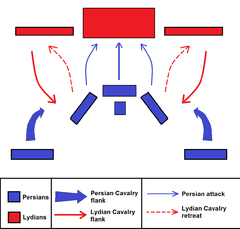Battle of Thymbra
| Battle of Thymbra | |||||||||
|---|---|---|---|---|---|---|---|---|---|
| Part of the Campaigns of Cyrus the Great | |||||||||
| |||||||||
| Belligerents | |||||||||
|
Lydian Kingdom, Arabian mercenaries, Babylonian mercenaries, Egyptian mercenaries | Achaemenid Empire | ||||||||
| Commanders and leaders | |||||||||
|
Croesus of Lydia, Artacamas of Phrygia, Aribaeus of Cappadocia, Aragdus of Arabia, Gabaedus of Hellespont, unknown others |
Cyrus the Great, Abradatas unknown others | ||||||||
| Strength | |||||||||
|
420,000 (Xenophon) 300 chariots (Xenophon) |
196,000 (Xenophon) 700 chariots (300 engaged), 5-6 siege towers (Xenophon) | ||||||||
| Casualties and losses | |||||||||
| Heavy | Light | ||||||||
The Battle of Thymbra was the decisive battle in the war between Croesus of the Lydian Kingdom and Cyrus the Great of the Achaemenid Empire. Cyrus, having pursued Croesus into Lydia following the drawn Battle of Pteria, met the remains of Croesus' partly disbanded army in battle on the plain north of Sardis on December, 547 BC. Even though Croesus' army was reinforced with many new men, Cyrus utterly defeated it, despite being outnumbered more or less 2:1. This proved decisive, and after the 14-day Siege of Sardis, the city and possibly its king fell, and Lydia was conquered by the Persians.
Situation
Cyrus's plan was to catch the Lydian king unprepared for battle, but at Thymbra Croesus had more than twice as many men as Cyrus. The Lydians marched out to meet Cyrus and quickly armed all the reserves there, before their allies were to arrive, which they never did. According to Xenophon, Cyrus had 196,000 men in total,[1] [2] which was composed of 31,000 to ~70,000 Persians. This consisted of 20,000 infantry which may have included archers and slingers, 10,000 elite infantry/ cavalry, which may have been the Persian Immortals, plus 20,000 peltasts and 20,000 pikemen. All except the archers and slingers are known to have carried small to large shields. The others were: 42,000 Arabians; Armenians; and Medians, which amounted to 126,000 infantry. There were also 300 camel cavalry, 300 chariots, and 5-6 siege towers, which were known to hold 20 men each. It all amounted to 1,000+ men, partly because there was one citizen, and one soldier on each chariot.
Xenophon tells us that Croesus had an army of 420,000 men,[3] which was composed of 60,000 Babylonians, Lydians, and Phrygians, also Cappadocians, plus nations of the Hellespont. This amounted to 300,000 men which included 60,000 cavalry. There were also 120,000 Egyptians, plus 300 chariots, which may have been at least 500 men. The numbers of the battle given by Xenophon, even if untrue, are considered within the realm of possibility, but less than half may have engaged in the actual battle.
The battle

Cyrus deployed his troops with flanks withdrawn in a square formation. The flanks were covered by chariots, cavalry, and his best infantry and a newly organized camel corps. This improvised camel corps was formed by camels taken from the baggage train, and its sole purpose was to disrupt the Lydian cavalry.
As Cyrus expected, the wings of the Lydian army wheeled inward to envelop this novel formation. As the Lydian flanks swung in, gaps appeared at the hinges of the wheeling wings. Disorder was increased by the effective overhead fire of the Persian archers and mobile towers, stationed within the square. Cyrus then gave the order to attack, his flank units smashing into Croesus' disorganized wings. Not long after the Lydian cavalry lose many soldiers and are forced to retreat. With most of his army intact and the loss of most of the Lydian cavalry, Cyrus orders all cavalry and infantry to attack the now crippled Lydian cavalry. After the cavalry are completely defeated, the Persian army attacks and brings heavy casualties to the Lydian infantry. Most of the infantry soon surrender but Croesus and a small part of the infantry retreat and head for the Lydian capital of Sardis, thus a decisive victory for the Persians. Herodotus gives an account of the battle but does not give any numbers. His account of the battle's progress and outcome, however, confirms that which Xenophon gives later.
Aftermath
After the battle all the Lydian lands were annexed by the Persian empire including the Greek cities of Ionia and Aeolis, which led to conflict between Greece and Persia. The surviving troops holed up in the nearby city of Ephesus and Sardis, which was captured after a short siege. According to the Greek author Herodotus, Cyrus treated Croesus well and with respect after the battle, but this is contradicted by the Nabonidus Chronicle,[4] one of the Babylonian Chronicles (although whether or not the text refers to Lydia's king or prince is unclear).
See also
Notes
- ↑ Campbell (1830), p. UNK.
- ↑ Kindersley (2005), p. 19
- ↑ Davis (1999), p. UNK.
- ↑ Jona Lendering. "Cyrus takes Babylon (539 BCE)". Livius.org. Retrieved 2015-10-17.
References
- Davis, Paul K. (1999). 100 Decisive Battles: From Ancient Times to the Present, Santa Barbara, CA, USA:PUBLISHER, ISBN 1576070751, URL.
- Campbell, Alexander (1830). The Millennial Harbinger, Vol. I, No. IX.
- Kindersley, Dorling & Grant, R.G. (2005). Battle: a Visual Journey Through 5000 Years of Combat, p, 19. London, ENG:PUBLISHER, ISBN, URL.